2021 NISSAN MICRA seats
[x] Cancel search: seatsPage 69 of 346
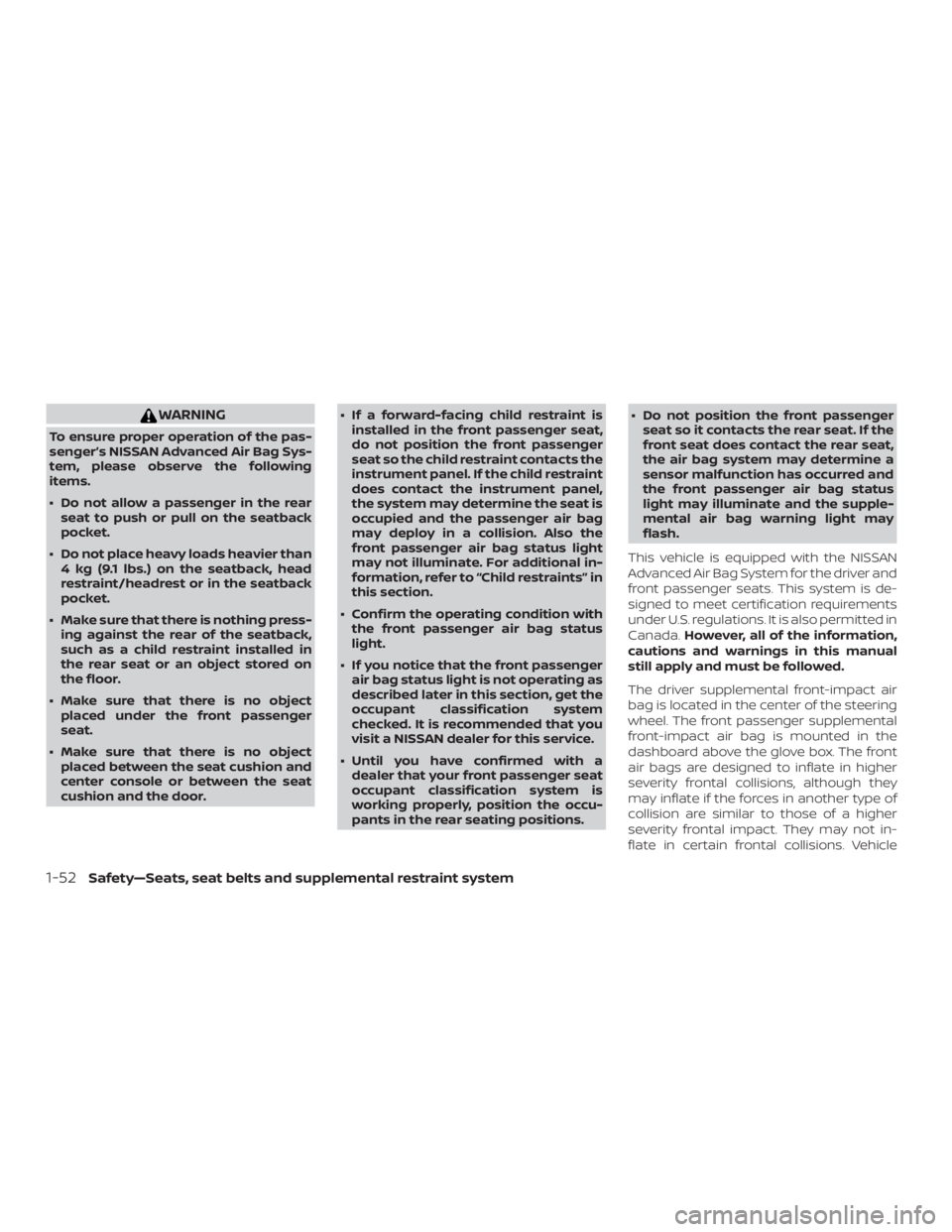
WARNING
To ensure proper operation of the pas-
senger’s NISSAN Advanced Air Bag Sys-
tem, please observe the following
items.
∙ Do not allow a passenger in the rearseat to push or pull on the seatback
pocket.
∙ Do not place heavy loads heavier than 4 kg (9.1 lbs.) on the seatback, head
restraint/headrest or in the seatback
pocket.
∙ Make sure that there is nothing press- ing against the rear of the seatback,
such as a child restraint installed in
the rear seat or an object stored on
the floor.
∙ Make sure that there is no object placed under the front passenger
seat.
∙ Make sure that there is no object placed between the seat cushion and
center console or between the seat
cushion and the door. ∙ If a forward-facing child restraint is
installed in the front passenger seat,
do not position the front passenger
seat so the child restraint contacts the
instrument panel. If the child restraint
does contact the instrument panel,
the system may determine the seat is
occupied and the passenger air bag
may deploy in a collision. Also the
front passenger air bag status light
may not illuminate. For additional in-
formation, refer to “Child restraints” in
this section.
∙ Confirm the operating condition with the front passenger air bag status
light.
∙ If you notice that the front passenger air bag status light is not operating as
described later in this section, get the
occupant classification system
checked. It is recommended that you
visit a NISSAN dealer for this service.
∙ Until you have confirmed with a dealer that your front passenger seat
occupant classification system is
working properly, position the occu-
pants in the rear seating positions. ∙ Do not position the front passenger
seat so it contacts the rear seat. If the
front seat does contact the rear seat,
the air bag system may determine a
sensor malfunction has occurred and
the front passenger air bag status
light may illuminate and the supple-
mental air bag warning light may
flash.
This vehicle is equipped with the NISSAN
Advanced Air Bag System for the driver and
front passenger seats. This system is de-
signed to meet certification requirements
under U.S. regulations. It is also permitted in
Canada. However, all of the information,
cautions and warnings in this manual
still apply and must be followed.
The driver supplemental front-impact air
bag is located in the center of the steering
wheel. The front passenger supplemental
front-impact air bag is mounted in the
dashboard above the glove box. The front
air bags are designed to inflate in higher
severity frontal collisions, although they
may inflate if the forces in another type of
collision are similar to those of a higher
severity frontal impact. They may not in-
flate in certain frontal collisions. Vehicle
1-52Safety—Seats, seat belts and supplemental restraint system
Page 76 of 346

∙ Tampering with the front air bag sys-tem may result in serious personal in-
jury. Tampering includes changes to
the steering wheel and the instru-
ment panel assembly by placing ma-
terial over the steering wheel pad and
above the instrument panel or by in-
stalling additional trim material
around the air bag system.
∙ Removing or modif ying the front pas- senger seat may affect the function of
the air bag system and result in seri-
ous personal injury.
∙ Modif ying or tampering with the front passenger seat may result in serious
personal injury. For example, do not
change the front seats by placing ma-
terial on the seat cushion or by install-
ing additional trim material, such as
seat covers, on the seat that are not
specifically designed to assure proper
air bag operation. Additionally, do not
stow any objects under the front pas-
senger seat or the seat cushion and
seatback. Such objects may interfere
with the proper operation of the occu-
pant classification sensor (weight
sensor). ∙ No unauthorized changes should be
made to any components or wiring of
the seat belt system. This may affect
the front air bag system. Tampering
with the seat belt system may result
in serious personal injury.
∙ It is recommended that you visit a NISSAN dealer for work on and around
the front air bag. It is also recom-
mended that you visit a NISSAN dealer
for installation of electrical equip-
ment. The Supplemental Restraint
System (SRS) wiring harnesses*
should not be modified or discon-
nected. Unauthorized electrical test
equipment and probing devices
should not be used on the air bag
system.
∙ A cracked windshield should be re- placed immediately by a qualified re-
pair facility. A cracked windshield
could affect the function of the
supplemental air bag system.
*The SRS wiring harness connectors are
yellow and orange for easy identifica-
tion. When selling your vehicle, we request that
you inform the buyer about the front air
bag system and guide the buyer to the
appropriate sections in this Owner’s
Manual.
Safety—Seats, seat belts and supplemental restraint system1-59
Page 78 of 346
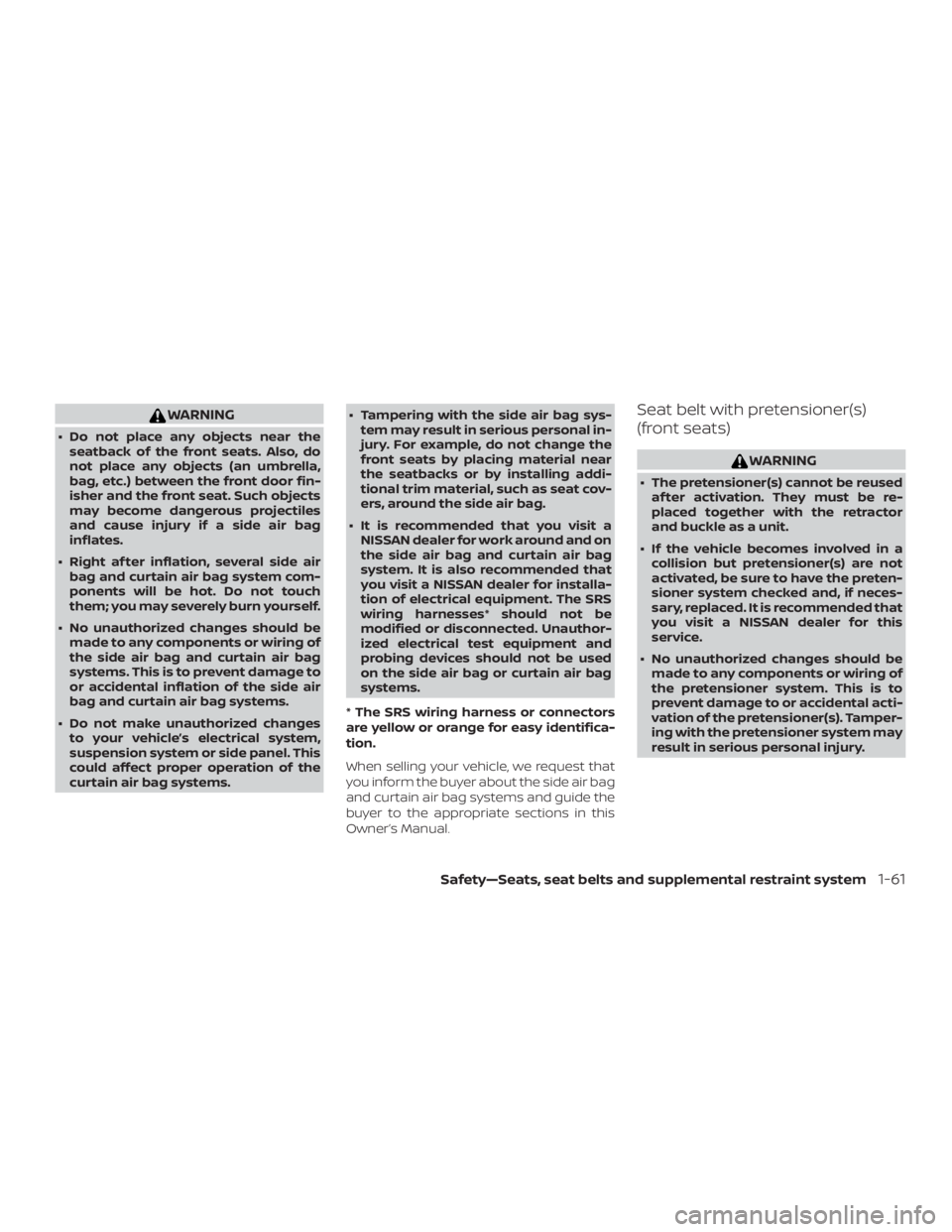
WARNING
∙ Do not place any objects near theseatback of the front seats. Also, do
not place any objects (an umbrella,
bag, etc.) between the front door fin-
isher and the front seat. Such objects
may become dangerous projectiles
and cause injury if a side air bag
inflates.
∙ Right af ter inflation, several side air bag and curtain air bag system com-
ponents will be hot. Do not touch
them; you may severely burn yourself.
∙ No unauthorized changes should be made to any components or wiring of
the side air bag and curtain air bag
systems. This is to prevent damage to
or accidental inflation of the side air
bag and curtain air bag systems.
∙ Do not make unauthorized changes to your vehicle’s electrical system,
suspension system or side panel. This
could affect proper operation of the
curtain air bag systems. ∙ Tampering with the side air bag sys-
tem may result in serious personal in-
jury. For example, do not change the
front seats by placing material near
the seatbacks or by installing addi-
tional trim material, such as seat cov-
ers, around the side air bag.
∙ It is recommended that you visit a NISSAN dealer for work around and on
the side air bag and curtain air bag
system. It is also recommended that
you visit a NISSAN dealer for installa-
tion of electrical equipment. The SRS
wiring harnesses* should not be
modified or disconnected. Unauthor-
ized electrical test equipment and
probing devices should not be used
on the side air bag or curtain air bag
systems.
* The SRS wiring harness or connectors
are yellow or orange for easy identifica-
tion.
When selling your vehicle, we request that
you inform the buyer about the side air bag
and curtain air bag systems and guide the
buyer to the appropriate sections in this
Owner’s Manual.
Seat belt with pretensioner(s)
(front seats)
Page 251 of 346
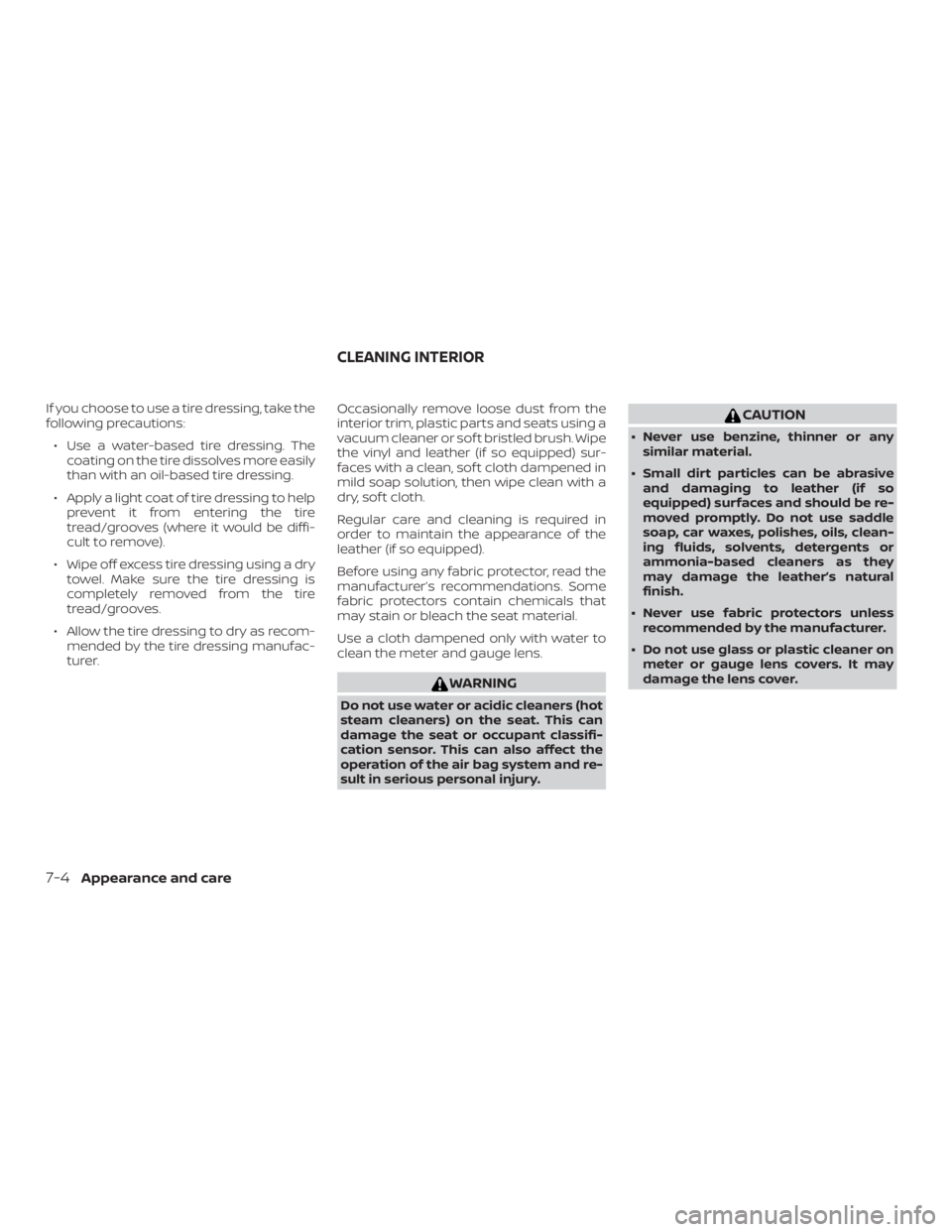
If you choose to use a tire dressing, take the
following precautions:∙ Use a water-based tire dressing. The coating on the tire dissolves more easily
than with an oil-based tire dressing.
∙ Apply a light coat of tire dressing to help prevent it from entering the tire
tread/grooves (where it would be diffi-
cult to remove).
∙ Wipe off excess tire dressing using a dry towel. Make sure the tire dressing is
completely removed from the tire
tread/grooves.
∙ Allow the tire dressing to dry as recom- mended by the tire dressing manufac-
turer. Occasionally remove loose dust from the
interior trim, plastic parts and seats using a
vacuum cleaner or sof t bristled brush. Wipe
the vinyl and leather (if so equipped) sur-
faces with a clean, sof t cloth dampened in
mild soap solution, then wipe clean with a
dry, sof t cloth.
Regular care and cleaning is required in
order to maintain the appearance of the
leather (if so equipped).
Before using any fabric protector, read the
manufacturer’s recommendations. Some
fabric protectors contain chemicals that
may stain or bleach the seat material.
Use a cloth dampened only with water to
clean the meter and gauge lens.
Page 327 of 346
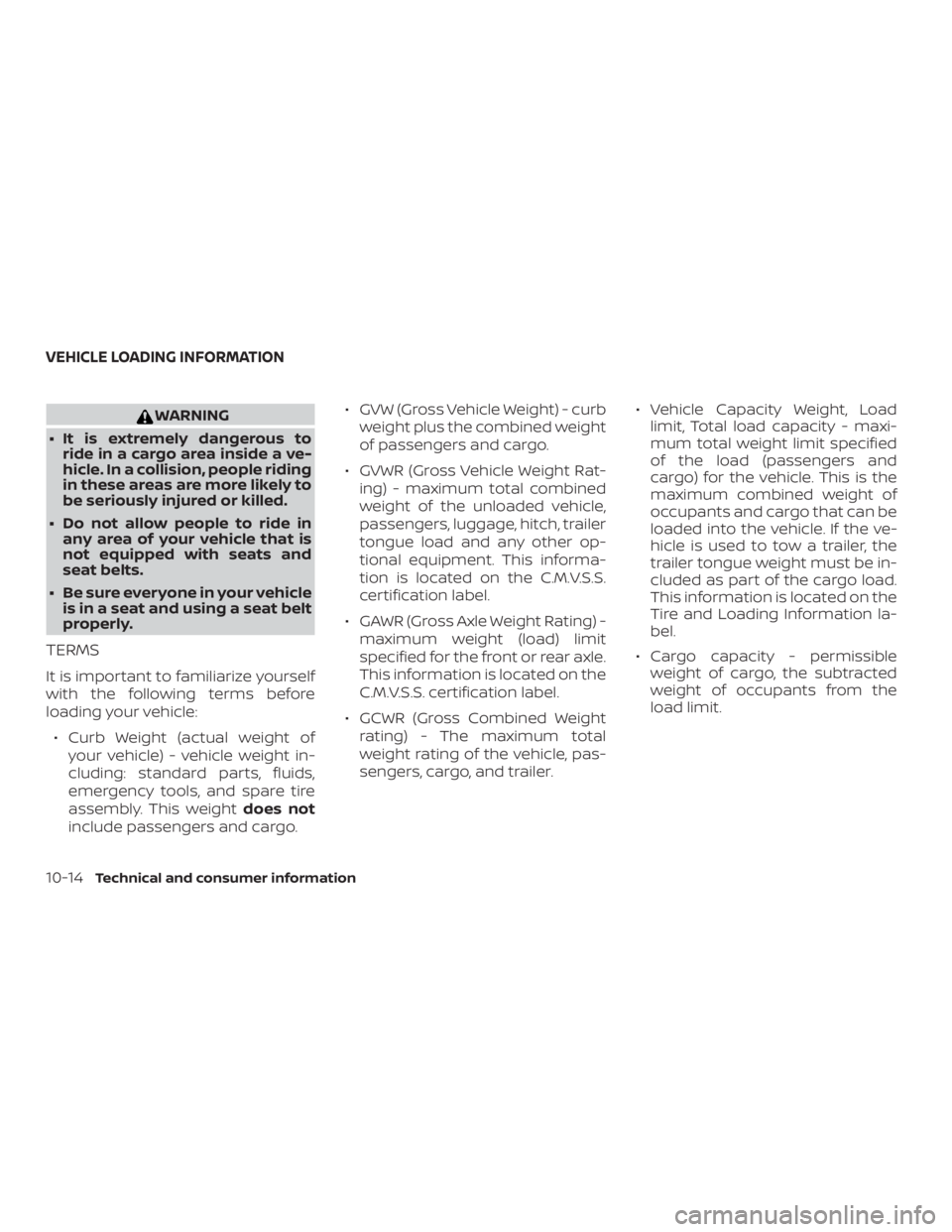
WARNING
∙ It is extremely dangerous to ride in a cargo area inside a ve-
hicle. In a collision, people riding
in these areas are more likely to
be seriously injured or killed.
∙ Do not allow people to ride in any area of your vehicle that is
not equipped with seats and
seat belts.
∙ Be sure everyone in your vehicle is in a seat and using a seat belt
properly.
TERMS
It is important to familiarize yourself
with the following terms before
loading your vehicle:
∙ Curb Weight (actual weight of your vehicle) - vehicle weight in-
cluding: standard parts, fluids,
emergency tools, and spare tire
assembly. This weight does not
include passengers and cargo. ∙ GVW (Gross Vehicle Weight) - curb
weight plus the combined weight
of passengers and cargo.
∙ GVWR (Gross Vehicle Weight Rat- ing) - maximum total combined
weight of the unloaded vehicle,
passengers, luggage, hitch, trailer
tongue load and any other op-
tional equipment. This informa-
tion is located on the C.M.V.S.S.
certification label.
∙ GAWR (Gross Axle Weight Rating) - maximum weight (load) limit
specified for the front or rear axle.
This information is located on the
C.M.V.S.S. certification label.
∙ GCWR (Gross Combined Weight rating) - The maximum total
weight rating of the vehicle, pas-
sengers, cargo, and trailer. ∙ Vehicle Capacity Weight, Load
limit, Total load capacity - maxi-
mum total weight limit specified
of the load (passengers and
cargo) for the vehicle. This is the
maximum combined weight of
occupants and cargo that can be
loaded into the vehicle. If the ve-
hicle is used to tow a trailer, the
trailer tongue weight must be in-
cluded as part of the cargo load.
This information is located on the
Tire and Loading Information la-
bel.
∙ Cargo capacity - permissible weight of cargo, the subtracted
weight of occupants from the
load limit.
VEHICLE LOADING INFORMATION
10-14Technical and consumer information
Page 338 of 346

Capacities and recommended
fuel/lubricants...............10-2
Clutchfluid.................8-10
Engine coolant...............8-4
Engine oil ...................8-6
Front air bag system
(See supplemental restraint system) . . .1-54
Front-door pocket ...............2-23
Frontseats................... .1-2
Fuel Capacities and recommended
fuel/lubricants...............10-2
Fuel economy ...............5-20
Fuel-filler cap ................3-11
Fuel-filler lid .................3-11
Fuel gauge ..................2-6
Fueloctanerating.............10-6
Fuel recommendation ..........10-4
Loose fuel cap warning ..........2-5
Fuelefficientdrivingtips...........5-19
Fuel-filler door ..................3-11
Fuel gauge ....................2-6
Fuses .......................8-18
Fusiblelinks...................8-18
G
Gascap......................3-11
Gauge Fuel gauge ..................2-6
Odometer ..................2-4
Speedometer ................2-4
Tachometer .................2-5
Trip computer ................2-6
Trip odometer ................2-4 General maintenance
.............9-2
Glovebox....................2-24
H
Hands-free phone system, Bluetooth® . .4-51
Hazard warning flasher switch ........6-2
Headlight and turn signal switch ......2-18
Headlightcontrolswitch...........2-18
Headlights ...................8-22
Headrestraints .................1-6
Heater Heater and air conditioner controls . .4-20
Heater operation .......4-14,4-16,4-22
Hood ........................3-9
Horn .......................2-21
I
Ignition switch ..................5-5
Immobilizer system ...........2-14,5-7
Important vehicle information label . . .10-12
In-cabinmicrofilter ..............8-15
Increasing fuel economy ..........5-20
Indicator lights and audible reminders
(See warning/indicator lights and audible
reminders) ....................2-11
Instrument brightness control .......2-20
Instrument panel .............0-6,2-2
Instrument panel dimmer switch .....2-20
Interiorlight...................2-29
iPod®Player ..................4-40
ISOFIX child restraints .............1-25 J
Jumpstarting...............6 -11, 8-13
K
Key........................ .3-2
Key fob battery replacement .....8-21,8-21
Keyless entry Without Intelligent Key system
(See remote keyless entry system) . . .3-7
Keyless entry system
(See remote keyless entry system) .....3-6
Keys NISSAN Vehicle Immobilizer System
keys......................3-3
L
Labels Air conditioner specification label . . .10-13
C.M.V.S.S. certification label .......10-12
Emission control information label . .10-12
Engine serial number ..........10-12
Tire and Loading Information label . .10-13
Vehicle identification number (VIN) . .10-11
V
ehicle identification number (VIN)
plate.....................10-11
Warning labels (for SRS) ..........1-62
LATCH (Lower Anchors and Tethers for
CHildren)System................1-25
Launch bar menu ................4-6
License plate Installing the license plate .......10-13
11-3
Page 340 of 346
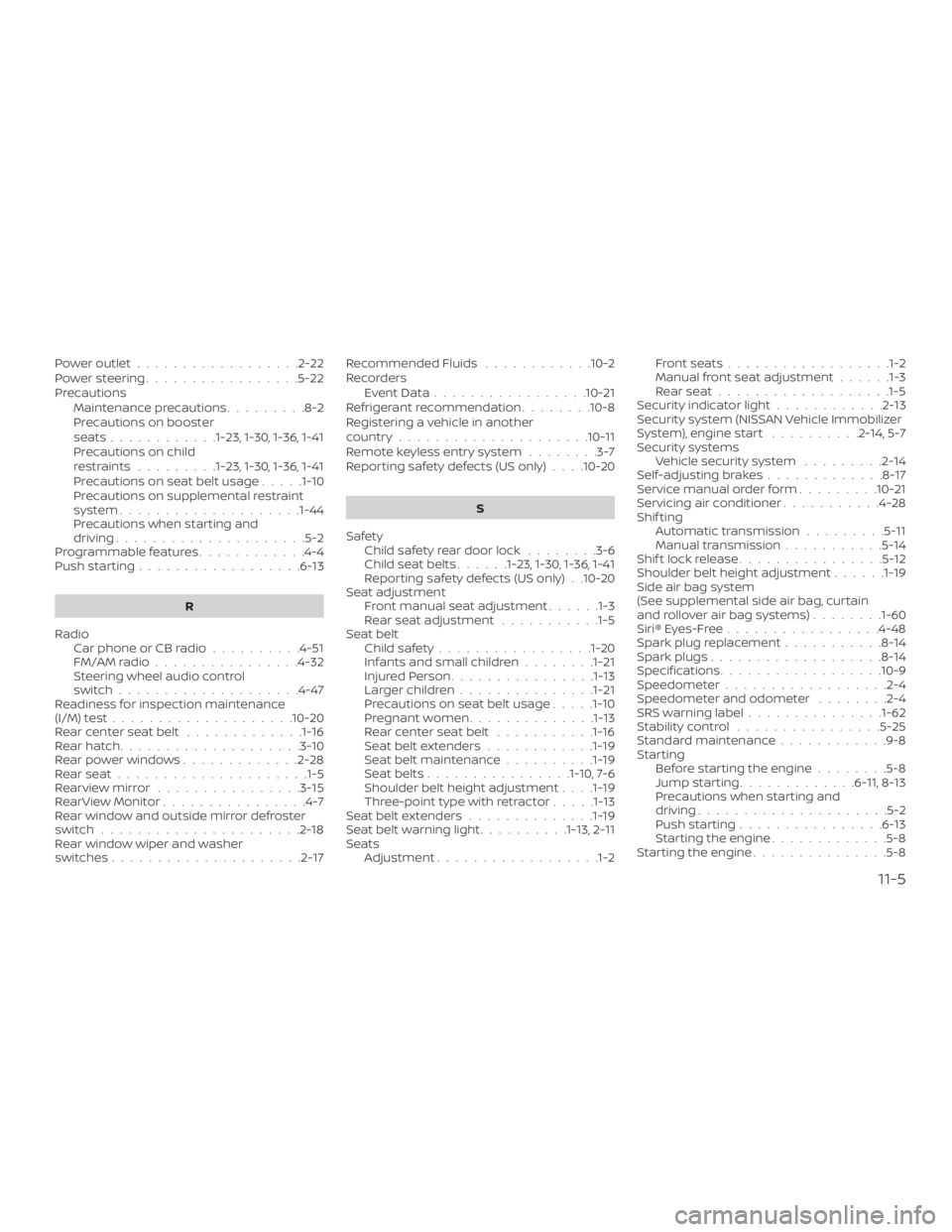
Poweroutlet..................2-22
Powersteering.................5-22
PrecautionsMaintenance precautions .........8-2
Precautions on booster
seats............1-23, 1-30, 1-36, 1-41
Precautions on child
restraints .........1-23, 1-30, 1-36, 1-41
Precautions on seat belt usage .....1-10
Precautions on supplemental restraint
system ....................1-44
Precautions when starting and
driving.....................5-2
Programmable features ............4-4
Push starting ..................6-13
R
Radio Car phone or CB radio ..........4-51
FM/AMradio................4-32
Steering wheel audio control
switch....................4-47
Readiness for inspection maintenance
(I/M)test....................10-20
Rearcenterseatbelt .............1-16
Rearhatch....................3-10
Rearpowerwindows.............2-28
Rearseat.................... .1-5
Rearviewmirror ................3-15
RearViewMonitor................4-7
Rear window and outside mirror defroster
switch......................2-18
Rear window wiper and washer
switches .....................2-17 Recommended Fluids
............10-2
Recorders EventData.................10-21
Refrigerant recommendation ........10-8
Registering a vehicle in another
country .....................10-11
Remote keyless entry system ........3-7
Reporting safety defects (US only) . . . .10-20
S
Safety Child safety rear door lock ........3-6
Childseatbelts......1-23, 1-30, 1-36, 1-41
Reporting safety defects (US only) . .10-20
Seat adjustment Front manual seat adjustment ......1-3
Rear seat adjustment ...........1-5
Seat belt Childsafety................ .1-20
Infants and small children ........1-21
InjuredPerson............... .1-13
Largerchildren.............. .1-21
Precautions on seat belt usage .....1-10
Pregnant women ..............1-13
Rearcenterseatbelt ...........1-16
Seat belt extenders ............1-19
Seat belt maintenance ..........1-19
Seatbelts................1-10, 7-6
Shoulder belt height adjustment . . . .1-19
Three-pointtypewithretractor.....1-13
Seat belt extenders ..............1-19
Seatbeltwarninglight..........1-13, 2-11
Seats Adjustment ..................1-2 Frontseats..................1-2
Manual front seat adjustment
......1-3
R
earseat...................1-5
Security indicator light ............2-13
Security system (NISSAN Vehicle Immobilizer
System), engine start ..........2-14, 5-7
Security systems Vehicle security system .........2-14
Self-adjustingbrakes.............8-17
Service manual order form .........10-21
Servicing air conditioner ...........4-28
Shif ting Automatic transmission .........5-11
Manual transmission ...........5-14
Shiftlockrelease................5-12
Shoulder belt height adjustment ......1-19
Side air bag system
(See supplemental side air bag, curtain
and rollover air bag systems) ........1-60
Siri® Eyes-Free .................4-48
Spark plug replacement ...........8-14
Spark plugs ...................8-14
Specifications ..................10-9
Speedometer ..................2-4
Speedometer and odometer ........2-4
SRS warning label ...............1-62
Stability control ................5-25
Standard maintenance ............9-8
Starting Before starting the engine ........5-8
Jumpstarting.............6 -11, 8-13
Precautions when starting and
driving .....................5-2
Push starting ................6-13
Starting the engine .............5-8
Starting the engine ...............5-8
11-5